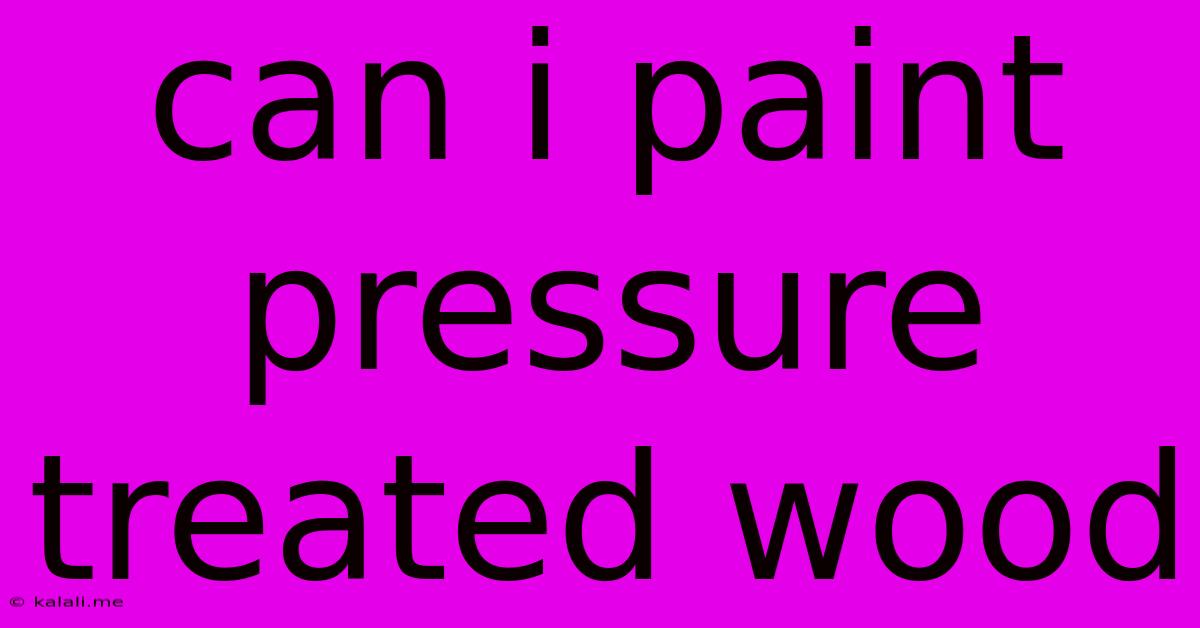Can I Paint Pressure Treated Wood
Kalali
May 31, 2025 · 3 min read

Table of Contents
Can I Paint Pressure Treated Wood? Yes, But Here's How
Painting pressure-treated wood might seem straightforward, but there are crucial factors to consider to ensure a long-lasting, beautiful finish. This article will guide you through the process, addressing common concerns and providing tips for success. Knowing the specifics of painting pressure-treated lumber will help you achieve a professional-looking result that withstands the elements.
Understanding Pressure-Treated Wood
Pressure-treated lumber is infused with preservatives, typically containing copper, chromium, and arsenic (CCA) in older treatments, or micronized copper azole (MCA) in newer, more environmentally friendly formulations. These chemicals protect the wood from rot, decay, and insect infestation, making it ideal for outdoor projects like decks, fences, and siding. However, these preservatives can interfere with paint adhesion, leading to peeling and premature failure if not handled correctly.
Why Proper Preparation is Key
The success of painting pressure-treated wood hinges on proper preparation. The preservatives within the wood can react negatively with certain paints, causing them to blister or peel. Therefore, thorough preparation is vital before you even think about picking up a paintbrush.
Essential Steps Before Painting:
- Allow Sufficient Curing Time: This is arguably the most crucial step. Freshly pressure-treated wood needs time to dry and allow the preservatives to dissipate. The required curing time varies depending on the type of treatment and wood species, but generally ranges from 3 to 12 months, sometimes even longer in humid climates. Check the manufacturer's recommendations on the lumber itself. Rushing this step almost guarantees paint failure.
- Clean the Wood: Use a stiff brush to remove any dirt, debris, mildew, or loose wood fibers. A pressure washer can be helpful, but be cautious not to damage the wood's surface.
- Sanding: Lightly sanding the surface will help create better paint adhesion. Use medium-grit sandpaper and focus on smoothing out any rough spots. Don't over-sand; you only need to create a slightly textured surface.
- Prime the Wood (Highly Recommended): A good quality primer specifically designed for pressure-treated wood is essential. This acts as a barrier between the wood preservatives and the paint, promoting better adhesion and preventing issues like blistering and peeling. Look for primers labeled as suitable for exterior use and pressure-treated lumber.
Choosing the Right Paint
Not all paints are created equal. Selecting the appropriate paint is just as important as the preparation process.
Paint Considerations:
- Acrylic-based Exterior Paints: These are generally the best choice for pressure-treated wood due to their flexibility, durability, and water resistance. Look for paints with good UV protection to prevent fading.
- Oil-based Paints (Less Recommended): While oil-based paints offer excellent durability, they are becoming less common due to environmental concerns and slower drying times. If you choose oil-based paint, ensure it's specifically formulated for exterior use and pressure-treated wood.
- Avoid Certain Finishes: Avoid using paints that are not designed for exterior applications or are known to be less durable.
The Painting Process
Once the wood is properly prepared and primed, the painting process is relatively straightforward.
Painting Techniques:
- Apply Thin Coats: Apply thin, even coats of paint to avoid runs and drips. Multiple thin coats are better than one thick coat.
- Allow Sufficient Drying Time: Allow each coat to dry completely before applying the next. Refer to the paint manufacturer's instructions for drying times.
- Proper Tools: Use quality brushes, rollers, or sprayers to achieve a smooth, even finish.
Maintaining Your Painted Pressure Treated Wood
Regular maintenance will extend the life of your painted pressure-treated wood. Inspect the paint regularly for any signs of peeling, blistering, or damage. Re-paint as needed to maintain protection and aesthetics.
By following these steps, you can confidently paint your pressure-treated wood and enjoy a beautiful, long-lasting finish. Remember, patience and proper preparation are key to achieving a successful result. Don't rush the process, and your hard work will be rewarded with a stunning and durable finish.
Latest Posts
Latest Posts
-
How To Fill Gaps In Timber Floorboards
Jun 01, 2025
-
How Long Should Wood Stain Dry Before Polyurethane
Jun 01, 2025
-
Steam Force A Stream To Close Game
Jun 01, 2025
-
How To Remove Email From Icloud
Jun 01, 2025
-
Jesus And John The Baptist Cousins
Jun 01, 2025
Related Post
Thank you for visiting our website which covers about Can I Paint Pressure Treated Wood . We hope the information provided has been useful to you. Feel free to contact us if you have any questions or need further assistance. See you next time and don't miss to bookmark.